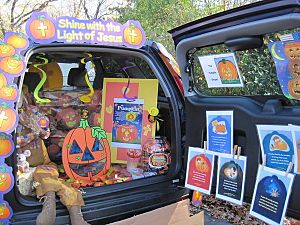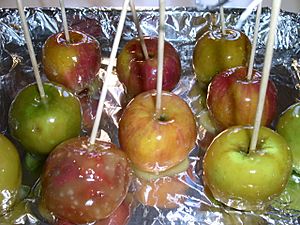Poisoned candy myths facts for kids
Poisoned candy myths are urban legends. These are stories about bad people supposedly putting poison or sharp things like razor blades, needles, or broken glass into candy. The stories claim these people give out the candy to hurt children, especially during Halloween trick-or-treating.
These stories are like modern cautionary tales for kids and parents. They often talk about danger to children and unsafe food. But here's the important part: there are no proven cases of strangers killing or seriously hurting children this way.
Sometimes, these stories appear in the news when a child dies suddenly after Halloween. However, medical checks always show that these children did not die from eating candy from strangers. In a few rare cases, adults in a family have spread these stories to hide a murder or an accident. Also, sometimes a child who has heard about poisoned candy might put something dangerous in their own candy and pretend a stranger did it. This is called the copycat effect.
Experts like folklorists, scholars, and police say that the idea of strangers putting poison in candy for trick-or-treaters has been "thoroughly debunked." This means it's been proven false. Because of these worries, new ways to celebrate Halloween have become popular. These include events at churches, police stations, community centers, and stores.
Contents
History of Candy Worries
People started to believe claims that candy was poisoned or changed during the Industrial Revolution. This was a time when food began to be made in factories, not just at home or by local people you knew. People worried about unknown ingredients and machines. Some doctors even claimed they treated children poisoned by candy every day. If a child got sick after eating candy, people often blamed the candy. But no cases of illness or death were ever proven.
In the early 1900s, the US Bureau of Chemistry tested many kinds of candy. They found no proof of poisons. They did find that cheap candies used glucose (from corn syrup) and some had tiny bits of copper from old cooking pans. Also, some colors came from coal tar dyes. But there was no evidence of poisons or garbage. Eventually, people realized that children getting sick from candy was likely due to indigestion from eating too much. Or it was from other causes, like food poisoning from poorly cooked or stored meat.
Why the Myths Stayed Around
These myths about candy stayed popular in the 1960s and 1970s. This was a time of big changes in society. People were unsure about who to trust. Stories about unknown neighbors hurting children during Halloween caught people's attention. These stories were more interesting than true stories about a mean neighbor or an accident at home.
How the Myths Changed Halloween

Because parents were afraid, they started to limit trick-or-treating. They created "safe" events instead. These included "trunk-or-treat" events at churches, where kids get candy from car trunks in a parking lot. Many local malls also started offering "safe" trick-or-treating. This fear also encouraged people to buy individually wrapped, brand-name candies. It made people less likely to give out homemade treats.
The Modern Candy-Tampering Myth
Several events in the late 1900s helped the modern candy tampering myth grow.
In 1959, a dentist gave out candy-coated laxative pills to trick-or-treaters. He was charged with breaking the law.
In 1964, a woman in Long Island, New York gave out packages of strange items. These included steel wool, dog biscuits, and ant poison (which was clearly labeled "poison"). She did this because she thought some kids were too old for trick-or-treating. No one was hurt, but she was charged with endangering children. That same year, news reports claimed lye was found in bubble gum in Detroit and rat poison in Philadelphia. But these reports were never proven true.
Another important step in spreading the myth was a The New York Times article in 1970. It warned that Halloween treats "may bring them more horror than happiness." It even gave examples of possible tampering.
Reports and copycat incidents became very common after the Chicago Tylenol murders in 1982. This happened just before Halloween. A person added poison to some bottles of over-the-counter medicine after they were in stores. This event made the candy tampering myth even stronger.
Proving the Myths Wrong
Joel Best, a sociologist at the University of Delaware, studies these candy-tampering legends. He looked at newspaper reports from 1958 to 1983. He found fewer than 90 cases that might have been real candy tampering. None of these were random attempts to harm children on Halloween. Most were attempts by adults to get money or, more often, by children to get attention. Best found five child deaths that police first thought were caused by strangers. But investigations always showed this was not true.
Children often copy these stories. They might put pins in their own candy or pour household cleaners on it. Then they tell their parents that the candy is unsafe. In these cases, the children are not hurt. They know the dangerous item is there and that it would be unsafe to eat the candy.
During the same time, there were many more reports of vandalism or children getting hurt in car accidents on Halloween.
Media and the Myth
Even though claims of poisoned candy were proven false, the news media kept reporting the story in the 1980s. Local news stations often covered it. They reported poisonings based on unproven claims or before a full investigation was done. Often, they never followed up to say the claims were false. This one-sided reporting made the public more afraid. Other news outlets also started reporting candy tampering. However, Joel Best says the myth didn't spread only because of the media. It also spread by word of mouth.
By 1985, the media had made people so scared about candy poisonings that a poll found 60% of parents feared their children would be hurt or killed by Halloween candy.
Advice columnists also joined in. Both Ask Ann Landers and Dear Abby warned parents about candy tampering: "In recent years, there have been reports of people with twisted minds putting razor blades and poison in taffy apples and Halloween candy. It is no longer safe to let your child eat treats that come from strangers." –Ann Landers in 1995 "Somebody's child will become violently ill or die after eating poisoned candy or an apple containing a razor blade." –Dear Abby in 1983
Candy Tampering by Friends and Family
Almost all real cases of candy tampering—about one or two per year—involve a friend or family member. These are usually done as a prank. Most of these cases involved sharp objects, not poison. Three-quarters of them caused no injuries, and the rest caused only minor injuries. No child has ever been killed by eating Halloween candy from a stranger.


